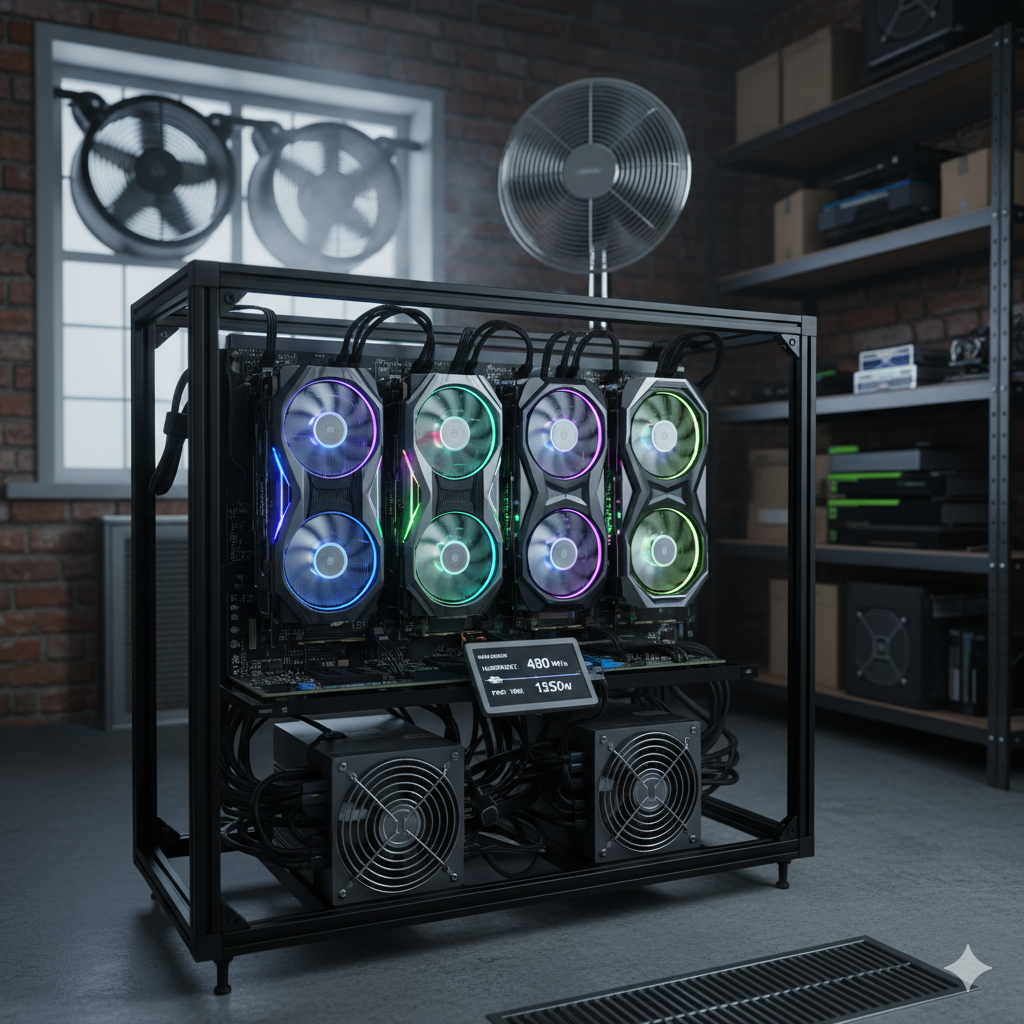ยินดีต้อนรับ นักสำรวจดิจิทัลในอนาคต! เคยสงสัยไหมว่าคริปโตเคอเรนซี่ที่เปล่งประกายอย่าง Bitcoin และ Ethereum เกิดขึ้นได้อย่างไร? มันไม่ใช่เวทมนตร์ แต่คือ "การขุด" (mining) – กระบวนการที่น่าทึ่งซึ่งเป็นส่วนหนึ่งของเทคโนโลยี ส่วนหนึ่งของเศรษฐศาสตร์ และจำเป็นอย่างยิ่งต่อโลกที่กระจายอำนาจของคริปโต หากคุณกำลังมองหาที่จะก้าวเข้าสู่สนามที่น่าตื่นเต้นนี้ในปี 2025 คุณมาถูกที่แล้ว คู่มือที่ครอบคลุมและเป็นมิตรต่อผู้เริ่มต้นนี้จะไขปริศนาของการขุดคริปโตเคอเรนซี่ ให้พื้นฐานที่มั่นคงแก่คุณเพื่อเริ่มต้นยุคตื่นทองดิจิทัลของคุณเอง ดังนั้น คว้าพลั่วเสมือนจริงของคุณ แล้วมาเริ่มขุดกัน!
การขุดคริปโตเคอเรนซี่คืออะไรกันแน่? 🤔
โดยหลักแล้ว การขุดคริปโตเคอเรนซี่คือกระบวนการที่สร้างหน่วยคริปโตเคอเรนซี่ใหม่ และมีการตรวจสอบและเพิ่มธุรกรรมลงใน บล็อกเชน (blockchain) ลองนึกถึง บล็อกเชน ว่าเป็นบัญชีแยกประเภทดิจิทัลขนาดใหญ่ สาธารณะ และไม่สามารถเปลี่ยนแปลงได้ ทุกครั้งที่มีคนส่งคริปโตไปยังอีกคนหนึ่ง ธุรกรรมนั้นจำเป็นต้องได้รับการบันทึกและยืนยัน นั่นคือจุดที่นักขุดเข้ามามีบทบาท!
นักขุดใช้คอมพิวเตอร์ที่ทรงพลังเพื่อไขปริศนาการคำนวณที่ซับซ้อน นักขุดคนแรกที่ไขปริศนาได้จะสามารถเพิ่ม "บล็อก" ใหม่ของธุรกรรมที่ได้รับการยืนยันไปยัง บล็อกเชน และเป็นรางวัล จะได้รับคริปโตเคอเรนซี่ที่สร้างขึ้นใหม่ และมักจะเป็นค่าธรรมเนียมการทำธุรกรรม มันคือการแข่งขันกับนักขุดคนอื่น ๆ การแข่งขันดิจิทัลเพื่อรางวัลอันมีค่านั้น
กระบวนการนี้ทำหน้าที่สำคัญสองอย่าง:
- การสร้างสกุลเงินใหม่: เป็นวิธีที่เหรียญใหม่เข้าสู่ระบบหมุนเวียน (เช่น Bitcoin ใหม่ถูก "ขุด")
- การยืนยันธุรกรรม; ความปลอดภัยของเครือข่าย: มันตรวจสอบความถูกต้องของธุรกรรม ป้องกันการใช้จ่ายซ้ำซ้อน และรักษาความปลอดภัยของเครือข่ายแบบกระจายอำนาจทั้งหมดจากการฉ้อโกงและการโจมตี หากไม่มีนักขุด บล็อกเชน ก็จะไม่สามารถทำงานได้!
วิวัฒนาการของการขุด: จาก CPU สู่ ASIC (และก้าวต่อไป!) 🚀
การขุดไม่ได้เป็นกิจกรรมที่ใช้เทคโนโลยีขั้นสูงเหมือนทุกวันนี้เสมอไป ในช่วงแรกของ Bitcoin คุณสามารถขุดได้อย่างมีประสิทธิภาพด้วย Central Processing Unit (CPU) ของคอมพิวเตอร์มาตรฐาน มันเป็นสิ่งที่ใครก็ตามที่มี PC สามารถทำได้จริงๆ!
- การขุดด้วย CPU (ยุคแรก): ช้า ไม่มีประสิทธิภาพ และตอนนี้ส่วนใหญ่ล้าสมัยสำหรับคริปโตเคอเรนซี่หลักๆ
- การขุดด้วย GPU (การเติบโตของกราฟิกการ์ด): เมื่อความยากเพิ่มขึ้น นักขุดตระหนักว่า Graphics Processing Units (GPU – ชิปอันทรงพลังในคอมพิวเตอร์เล่นเกม) มีประสิทธิภาพมากกว่ามาก สิ่งนี้นำไปสู่ความเฟื่องฟูในการขุดด้วย GPU โดยเฉพาะอย่างยิ่งสำหรับ altcoins (สกุลเงินดิจิทัลทางเลือก) หลายคนยังคงใช้ GPU ในปัจจุบันสำหรับเหรียญบางชนิด!
- การขุดด้วย FPGA (ช่วงพักสั้นๆ): Field-Programmable Gate Arrays (FPGA) นำเสนอทางสายกลางระหว่าง GPU และ ASIC ในแง่ของประสิทธิภาพ แต่ความซับซ้อนของมันจำกัดการยอมรับในวงกว้าง
- การขุดด้วย ASIC (Application-Specific Integrated Circuits) (การปฏิวัติอุตสาหกรรมของคริปโต): Application-Specific Integrated Circuits (ASIC) เป็นฮาร์ดแวร์พิเศษที่ออกแบบมาเพื่อขุดอัลกอริทึมสกุลเงินดิจิทัลเฉพาะเท่านั้น (เช่น SHA-256 สำหรับ Bitcoin) สิ่งเหล่านี้มีประสิทธิภาพและประสิทธิผลอย่างไม่น่าเชื่อ แต่ก็มีราคาแพงและมีเสียงดังเช่นกัน ASICs ครองการดำเนินการขุด Bitcoin และเหรียญหลักอื่น ๆ อีกมากมายในปัจจุบัน
- Proof-of-Stake (PoS) – กระบวนทัศน์ที่แตกต่าง: เป็นสิ่งสำคัญที่จะกล่าวถึงว่าไม่ใช่ทุกสกุลเงินดิจิทัลที่จะใช้ "การขุด" ในความหมายดั้งเดิม ตัวอย่างเช่น Ethereum ได้เปลี่ยนไปจากกลไกฉันทามติ Proof-of-Work (PoW) (ซึ่งต้องใช้การขุด) เป็น Proof-of-Stake (PoS) แล้ว ใน PoS แทนที่จะแก้ปริศนาด้วยพลังการคำนวณ ผู้ตรวจสอบ (validators) จะ "วางเดิมพัน" (stake) คริปโตที่มีอยู่เป็นหลักประกันเพื่อยืนยันธุรกรรมและสร้างบล็อกใหม่ โดยได้รับรางวัลเป็นการตอบแทน สิ่งนี้โดยทั่วไปมีประสิทธิภาพด้านพลังงานมากกว่า เราจะเน้นไปที่การขุด PoW สำหรับคำแนะนำนี้ แต่จำไว้ว่า PoS เป็นส่วนสำคัญของภูมิทัศน์คริปโต!
ทำไมต้องขุด (Mine) ในปี 2025? ยังคงทำกำไรได้อยู่หรือไม่? 🤔💸
นี่คือคำถามล้านดอลลาร์! ความสามารถในการทำกำไรของการขุดมีความผันผวนอย่างมากในช่วงหลายปีที่ผ่านมา ในปี 2025 การเสียบปลั๊กคอมพิวเตอร์พื้นฐานและรอดูคริปโตไหลเข้ามาย่อมไม่ใช่วิธีที่ง่ายดายอีกต่อไป ปัจจัยที่ส่งผลต่อความสามารถในการทำกำไร ได้แก่:
- ราคาคริปโตเคอร์เรนซี: ยิ่งมูลค่าตลาดของเหรียญที่คุณกำลังขุดสูงเท่าใด รางวัลของคุณก็จะมีค่ามากขึ้นเท่านั้น
- ความยากในการขุด: เมื่อนักขุดเข้าร่วมเครือข่ายมากขึ้น ความยากของปริศนาก็จะเพิ่มขึ้น ทำให้การรับรางวัลยากขึ้น
- ต้นทุนฮาร์ดแวร์: การลงทุนเริ่มต้นใน ASIC หรือ GPU (หน่วยประมวลผลกราฟิก) อาจมีจำนวนมาก
- ค่าไฟฟ้า: การขุดใช้พลังงานมาก นี่มักเป็นค่าใช้จ่ายต่อเนื่องที่ใหญ่ที่สุด
- ประสิทธิภาพของฮาร์ดแวร์ของคุณ: ฮาร์ดแวร์ที่ใหม่กว่าและมีประสิทธิภาพมากกว่าจะใช้พลังงานน้อยลงสำหรับการประมวลผลที่เท่ากัน
- ค่าธรรมเนียม Pool: หากคุณเข้าร่วม mining pool (ซึ่งคุณน่าจะทำ) พวกเขาจะหักเปอร์เซ็นต์เล็กน้อยจากรายได้ของคุณ
แม้ว่าการขุด Bitcoin เป็นงานอดิเรกส่วนตัวด้วย ASIC เพียงตัวเดียวอาจเป็นเรื่องท้าทายที่จะทำให้มีกำไรอย่างต่อเนื่องในภูมิภาคที่มีค่าไฟฟ้าสูง แต่ก็ยังมีโอกาส:
- การขุด Altcoin (GPU): คริปโตเคอร์เรนซีขนาดเล็กและใหม่กว่าจำนวนมากยังคงใช้ PoW (Proof-of-Work) และสามารถขุดได้อย่างมีกำไรด้วย GPU (หน่วยประมวลผลกราฟิก) สิ่งเหล่านี้มักมีความยากต่ำกว่าและการแข่งขันน้อยกว่า
- ความได้เปรียบทางภูมิศาสตร์: หากคุณสามารถเข้าถึงไฟฟ้าที่ถูกมาก (เช่น แหล่งพลังงานหมุนเวียน เขตอุตสาหกรรมเฉพาะ) ความสามารถในการทำกำไรของคุณจะเพิ่มขึ้นอย่างมาก
- การ HODLing ระยะยาว: นักขุดบางรายให้ความสำคัญกับกำไร fiat ในทันทีน้อยกว่า และให้ความสำคัญกับการสะสมคริปโตเพื่อเพิ่มมูลค่าในอนาคต
The key takeaway: Don’t go into mining blindly! Do your research and calculate potential profitability meticulously before investing.
การเริ่มต้น: รายการตรวจสอบการขุดของคุณสำหรับปี 2025 📋
พร้อมที่จะเริ่มเส้นทางการขุดของคุณแล้วหรือยัง? นี่คือสิ่งที่คุณจะต้องมี:
1. เลือกสกุลเงินดิจิทัลและอัลกอริทึมของคุณ 🎯
อันดับแรก ให้ตัดสินใจว่าคุณต้องการขุดอะไร สิ่งนี้จะกำหนดฮาร์ดแวร์ของคุณ
- Bitcoin (BTC): ใช้อัลกอริทึม SHA-256 ต้องใช้นักขุด ASIC ที่มีราคาแพงและมีความเชี่ยวชาญ
- Litecoin (LTC), Dogecoin (DOGE): ใช้อัลกอริทึม Scrypt สามารถขุดได้ด้วย ASIC หรือ GPU ที่ทรงพลัง (แม้ว่า ASIC จะโดดเด่นกว่าสำหรับเหรียญเฉพาะเหล่านี้)
- Ethereum Classic (ETC) และ Altcoin แบบ PoW อื่น ๆ: จำนวนมากใช้อัลกอริทึม เช่น Ethash (หรือรูปแบบต่างๆ) ขุดโดยใช้ GPU (หน่วยประมวลผลกราฟิก) เป็นหลัก นี่มักเป็นจุดเริ่มต้นสำหรับนักขุดใหม่
- Monero (XMR): ใช้อัลกอริทึม RandomX ซึ่งออกแบบมาให้เป็นมิตรกับ CPU (หน่วยประมวลผลกลาง) มากกว่า แม้ว่า GPU ก็สามารถใช้งานได้อย่างมีประสิทธิภาพเช่นกัน
วิจัยอย่างรอบคอบ! ดูปัจจัยต่างๆ เช่น:
- มูลค่าตลาด; ประวัติราคา: เหรียญมีความเสถียรหรือไม่? มีศักยภาพในการเติบโตหรือไม่?
- ความยากในการขุด; อัตราแฮช (Hash Rate): เครือข่ายมีการแข่งขันมากน้อยเพียงใด?
- อัลกอริทึม: ต้องใช้อุปกรณ์ฮาร์ดแวร์อะไร?
- ชุมชน; การพัฒนา: โครงการได้รับการดูแลอย่างกระตือรือร้นหรือไม่?
2. จัดหาฮาร์ดแวร์ที่เหมาะสม 💻
นี่คือการลงทุนล่วงหน้าที่ใหญ่ที่สุดของคุณ
ก. สำหรับการขุดด้วย ASIC (Bitcoin, Litecoin, ฯลฯ):
คุณจะต้องมีเครื่องขุด ASIC เหล่านี้เป็นเครื่องจักรที่ทรงพลัง สร้างขึ้นตามวัตถุประสงค์เฉพาะ
ข้อควรพิจารณา:
- Hash Rate: กำลังดิบของเครื่องขุด (เช่น Terahashes ต่อวินาที – TH/s) ยิ่งสูงยิ่งดี
- ประสิทธิภาพพลังงาน: จำนวนจูลต่อเทราแฮช (J/TH) หรือวัตต์ต่อ TH ที่ใช้ ยิ่งต่ำยิ่งดี สิ่งนี้ส่งผลกระทบโดยตรงต่อค่าไฟฟ้าของคุณ
- ราคา: ASIC อาจมีราคาตั้งแต่ไม่กี่ร้อยถึงหลายพันดอลลาร์
- เสียงและอุณหภูมิ: ASIC มีเสียงดังอย่างไม่น่าเชื่อและสร้างความร้อนมหาศาล พวกเขาต้องการการระบายอากาศโดยเฉพาะและพื้นที่ที่แยกเสียงรบกวน
ข. สำหรับการขุดด้วย GPU (Ethereum Classic, Altcoins PoW อื่นๆ):
คุณจะสร้าง "เครื่องขุด" (mining rig) ซึ่งโดยพื้นฐานแล้วเป็นคอมพิวเตอร์พิเศษที่มีการ์ดจอที่ทรงพลังหลายตัว
ส่วนประกอบ:
- หลาย GPU: หัวใจของริกของคุณ เล็งไปที่การ์ด AMD Radeon หรือ NVIDIA GeForce ระดับกลางถึงสูง (เช่น ซีรีส์ RX 6000, ซีรีส์ RTX 30 หรือใหม่กว่า)

- เมนบอร์ด: ต้องมีสล็อต PCIe เพียงพอเพื่อรองรับ GPU ทั้งหมดของคุณ
- CPU (หน่วยประมวลผลกลาง): โดยปกติแล้ว CPU (หน่วยประมวลผลกลาง) พื้นฐานราคาถูกก็เพียงพอแล้ว
- RAM: 8GB-16GB โดยทั่วไปก็เพียงพอแล้ว
- Storage (SSD): SSD ขนาดเล็ก (120-250GB) สำหรับระบบปฏิบัติการและซอฟต์แวร์การขุดของคุณ
- หน่วยจ่ายไฟ: สำคัญอย่างยิ่ง! คุณจะต้องมีหน่วยจ่ายไฟ (PSU) ที่ทรงพลังและเชื่อถือได้เพื่อจ่ายพลังงานให้กับ GPU ที่หิวกระหายเหล่านั้นทั้งหมด บ่อยครั้งที่ใช้ PSU หลายตัว
- โครงสร้างการขุดแบบเปิด: เพื่อติดตั้งส่วนประกอบทั้งหมดของคุณ อนุญาตให้มีการไหลเวียนของอากาศที่ดี และรักษาความเย็น
- PCIe Risers: สายเคเบิลที่เชื่อมต่อ GPU กับเมนบอร์ด ทำให้สามารถเว้นระยะห่างได้ดีขึ้น
- Operating System: มักจะเป็น OS น้ำหนักเบาที่ใช้ Linux เช่น HiveOS หรือ RaveOS ซึ่งออกแบบมาโดยเฉพาะสำหรับการขุด
3. รักษาความปลอดภัยของกระเป๋าสตางค์คริปโต 🔒
ก่อนที่คุณจะเริ่มขุด คุณต้องมีที่ที่ปลอดภัยสำหรับจัดเก็บเหรียญที่คุณได้รับ Cryptocurrency wallet เป็นสิ่งจำเป็น
- ซอฟต์แวร์วอลเล็ต (Hot Wallets): แอปพลิเคชันบนคอมพิวเตอร์หรือโทรศัพท์ของคุณ สะดวก แต่โดยทั่วไปแล้วมีความปลอดภัยน้อยกว่าเนื่องจากเชื่อมต่อกับอินเทอร์เน็ต
- ฮาร์ดแวร์วอลเล็ต (Hardware Wallets) (กระเป๋าสตางค์เย็น): อุปกรณ์ทางกายภาพ (เช่น USB stick) ที่เก็บ private key ของคุณแบบ offline ปลอดภัยสูง แนะนำสำหรับ crypto จำนวนมาก ตัวอย่าง: Ledger, Trezor
สำรองข้อมูล seed phrase (รายการคำ) ของคุณเสมอ และเก็บรักษาไว้อย่างปลอดภัยสูงสุดแบบ offline นี่คือกุญแจสู่ crypto ของคุณ!
4. เข้าร่วม Mining Pool 🏊♂️
เว้นแต่คุณจะมีระบบการขุดขนาดใหญ่ การขุดคนเดียวสำหรับสกุลเงินดิจิทัลหลักก็เหมือนกับการพยายามถูกลอตเตอรี่ด้วยตั๋วเพียงใบเดียว โอกาสที่คุณจะแก้ block ได้เองนั้นน้อยมากอย่างไม่น่าเชื่อ
นี่คือสิ่งที่ mining pools เข้ามามีบทบาท mining pool คือกลุ่มของ miners ที่รวมพลังในการประมวลผลเพื่อเพิ่มโอกาสในการแก้ block เมื่อ pool ขุด block ได้สำเร็จ รางวัลจะถูกแบ่งให้กับผู้เข้าร่วมทุกคนตามสัดส่วนของกำลัง hashing ที่พวกเขาได้มีส่วนร่วม
Mining Pools ยอดนิยม (ตรวจสอบสำหรับเหรียญเฉพาะของคุณ):
- F2Pool
- ViaBTC
- AntPool
- NiceHash (แตกต่างเล็กน้อย, ให้เช่า/ซื้อ hash power)
ข้อควรพิจารณาในการเลือก pool:
- ค่าธรรมเนียม Pool: โดยทั่วไป 1-4%
- เกณฑ์การจ่ายเงิน (Payout Thresholds): จำนวนเงินขั้นต่ำที่คุณต้องได้รับก่อนที่เงินจะถูกโอนไปยัง wallet ของคุณ
- รูปแบบการจ่ายเงิน (Payment Scheme): วิธีการกระจายรางวัล (เช่น PPS, PPLNS)
- ชื่อเสียงและความน่าเชื่อถือ (Reputation & Reliability): เลือก pool ที่ได้รับการยอมรับ
5. ติดตั้งซอฟต์แวร์การขุด ⚙️
เมื่อคุณมีฮาร์ดแวร์และได้เข้าร่วม pool แล้ว คุณต้องมีซอฟต์แวร์เพื่อให้ทุกอย่างทำงานได้
- สำหรับ ASIC: มักจะมาพร้อมกับ firmware ที่ติดตั้งไว้ล่วงหน้า โดยทั่วไปคุณจะเข้าถึงเว็บอินเทอร์เฟซเพื่อกำหนดค่าด้วยรายละเอียด pool ของคุณ
- สำหรับ GPU Rigs: คุณจะต้องติดตั้งระบบปฏิบัติการสำหรับการขุด (เช่น HiveOS, RaveOS หรือแม้แต่ Windows ที่มีซอฟต์แวร์เฉพาะ) จากนั้นติดตั้งไคลเอนต์สำหรับการขุด ไคลเอนต์ GPU mining ยอดนิยม ได้แก่:
- T-Rex Miner
- GMiner
- LolMiner
- NBminer
ไคลเอนต์เหล่านี้ได้รับการกำหนดค่าด้วยที่อยู่ pool ที่คุณเลือก ที่อยู่ wallet ของคุณ (มักจะเป็น "ชื่อผู้ใช้" ของคุณใน pool) และรหัสผ่าน (มักจะเป็น "x" หรือชื่อผู้ปฏิบัติงาน)
6. เปิดเครื่องและเฝ้าติดตาม! ⚡️📊
เมื่อทุกอย่างถูกตั้งค่าเรียบร้อยแล้ว:
- เชื่อมต่อกับพลังงานและอินเทอร์เน็ต: ตรวจสอบให้แน่ใจว่าการตั้งค่าของคุณมีความเสถียร
- เริ่มซอฟต์แวร์การขุด: เริ่มต้นกระบวนการขุด.
- ตรวจสอบ Rig ของคุณ: ที่สำคัญที่สุด ให้จับตาดู:
- อุณหภูมิ: GPU / ASIC ที่ทำงานร้อนเกินไปจะลดประสิทธิภาพและทำให้อายุการใช้งานสั้นลง ตรวจสอบให้แน่ใจว่ามีการระบายความร้อนที่เพียงพอ!
- Hash Rate: กำลังขุดที่แท้จริงของคุณ.
- การใช้พลังงาน: ใช้มิเตอร์ kill-a-watt เพื่อดูปริมาณการใช้จริง
- การปฏิเสธ / ข้อผิดพลาด: อัตราการปฏิเสธที่สูงหมายความว่ามีบางอย่างผิดปกติ
- รายได้: Pool ส่วนใหญ่มี dashboard เพื่อติดตามรายได้แบบเรียลไทม์ของคุณ
การขุดเป็นกระบวนการที่ต่อเนื่อง คุณจะต้องตรวจสอบอุปกรณ์ของคุณเป็นประจำ อัปเดตซอฟต์แวร์ และอาจปรับการตั้งค่าเพื่อประสิทธิภาพและประสิทธิผลสูงสุด
ข้อพิจารณาที่สำคัญสำหรับนักขุดในปี 2025 🙏
- ค่าไฟฟ้า: อย่างจริงจัง เรื่องนี้เน้นย้ำไม่พอ ราคาไฟฟ้าที่สูงอาจเปลี่ยนการดำเนินการที่ทำกำไรให้กลายเป็นหลุมเงินได้อย่างรวดเร็ว ศึกษาอัตราค่าบริการในพื้นที่ของคุณ!
- เสียงและอุณหภูมิ: ฮาร์ดแวร์การขุดสร้างความร้อนและเสียงรบกวนจำนวนมาก นี่ไม่ใช่สิ่งที่คุณต้องการในห้องนอนของคุณ การระบายอากาศที่เหมาะสมและพื้นที่เฉพาะเป็นสิ่งสำคัญ
- การเชื่อมต่ออินเทอร์เน็ต: การเชื่อมต่ออินเทอร์เน็ตที่เสถียรและเชื่อถือได้เป็นสิ่งสำคัญอย่างยิ่ง
- การบำรุงรักษา: การสะสมของฝุ่น การทำงานผิดพลาดของพัดลม และการสึกหรอทั่วไปเป็นเรื่องปกติ เตรียมพร้อมสำหรับการบำรุงรักษาเป็นประจำ
- ความผันผวนของตลาด: ราคาคริปโตเคอร์เรนซีมีความผันผวนอย่างมาก สิ่งที่ทำกำไรได้ในวันนี้อาจไม่ทำกำไรในวันพรุ่งนี้ จงมีมุมมองระยะยาว
- ข้อบังคับ: กฎระเบียบของคริปโตเคอร์เรนซีมีการพัฒนาอย่างต่อเนื่อง ติดตามข่าวสารเกี่ยวกับกฎหมายในภูมิภาคของคุณเกี่ยวกับการขุดและรายได้จากคริปโตเคอร์เรนซี
- ผลกระทบต่อสิ่งแวดล้อม: การขุด (โดยเฉพาะ PoW) ใช้พลังงานอย่างมาก ลองพิจารณาใช้แหล่งพลังงานหมุนเวียนหากเป็นไปได้ เพื่อลดการปล่อยคาร์บอนของคุณ 🌍
- การหลอกลวง: ระวังโครงการหลอกลวง การหลอกลวง cloud mining และผู้ขายฮาร์ดแวร์ที่น่าสงสัย ดำเนินการตรวจสอบวิเคราะห์สถานะของคุณ!
การขุดบนคลาวด์เป็นทางเลือกหรือไม่? ☁️
การขุดบนคลาวด์เกี่ยวข้องกับการจ่ายเงินให้บริษัทเพื่อเช่ากำลังการประมวลผล (hashing power) จากศูนย์ข้อมูลของพวกเขา คุณไม่ได้เป็นเจ้าของฮาร์ดแวร์ เพียงแต่จ่ายค่าธรรมเนียมและรับส่วนแบ่งของคริปโตที่ขุดได้
ข้อดี: ไม่มีค่าใช้จ่ายด้านฮาร์ดแวร์ล่วงหน้า, ไม่มีเสียงรบกวน/ความร้อน/การบำรุงรักษา, ความกังวลเกี่ยวกับไฟฟ้าอาจน้อยลง
ข้อเสีย: ความเสี่ยงสูงต่อการหลอกลวง, ผลกำไรต่ำกว่า (เนื่องจากค่าธรรมเนียม), ควบคุมน้อยกว่า, คุณต้องพึ่งพาประสิทธิภาพและความซื่อสัตย์ของบริษัท cloud mining
ในปี 2025 แม้ว่าจะมีบริการขุดบนคลาวด์ที่ถูกกฎหมายอยู่บ้าง แต่พื้นที่นี้ก็ยังเต็มไปด้วยการหลอกลวง ดำเนินการด้วยความระมัดระวังอย่างยิ่งและค้นคว้าอย่างละเอียดถี่ถ้วนหากพิจารณาตัวเลือกนี้ หลายคนจะแนะนำไม่ให้มือใหม่ใช้
อนาคตของการขุด: หลังปี 2025 และ PoS 🔮
ในขณะที่การขุดแบบ Proof-of-Work ยังคงดำเนินต่อไปสำหรับสกุลเงินดิจิทัลจำนวนมาก แนวโน้มไปสู่ Proof-of-Stake และกลไกฉันทามติอื่น ๆ นั้นปฏิเสธไม่ได้ ซึ่งได้รับแรงหนุนจากความกังวลเกี่ยวกับการใช้พลังงานและการกระจายอำนาจ การรวม Ethereum เข้ากับ PoS ที่ประสบความสำเร็จถือเป็นเหตุการณ์สำคัญ
อย่างไรก็ตาม PoW จะไม่หายไปทั้งหมด Bitcoin ซึ่งเป็นสกุลเงินดิจิทัลที่ใหญ่ที่สุดยังคงเป็น PoW อย่างมั่นคง โครงการเกิดใหม่อื่น ๆ อีกมากมายก็เลือก PoW เนื่องจากความปลอดภัยและความเรียบง่ายที่รับรู้ ดังนั้น การทำความเข้าใจ PoW mining จึงยังคงเป็นทักษะที่มีค่าในโลกคริปโต
สรุป: การตื่นทองดิจิทัลของคุณรออยู่! ✨
การขุด Cryptocurrency ในปี 2025 เป็นความพยายามที่ซับซ้อน แต่มีโอกาสได้รับผลตอบแทนที่ดี ต้องมีการวางแผนอย่างรอบคอบ การลงทุนล่วงหน้าจำนวนมาก และการตรวจสอบอย่างต่อเนื่อง ไม่ใช่แผนการรวยทางลัด แต่เป็นการมุ่งมั่นที่จะมีส่วนร่วมในเครือข่ายแบบกระจายอำนาจ ในขณะที่อาจได้รับสินทรัพย์ดิจิทัล
ด้วยความเข้าใจใน hardware, software, ปัจจัยทางเศรษฐกิจ และความเสี่ยงที่เกี่ยวข้อง คุณสามารถตัดสินใจได้อย่างมีข้อมูลและเริ่มต้นการเดินทางของคุณเองสู่โลกแห่งการขุดคริปโตที่น่าสนใจ ขอให้โชคดี นักสำรวจดิจิทัล – ขอให้ hash rate ของคุณสูงและค่าไฟฟ้าของคุณต่ำ! ขุดอย่างมีความสุข! ⛏️💰🚀
